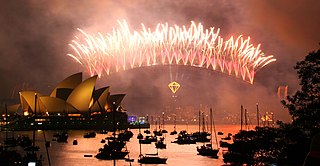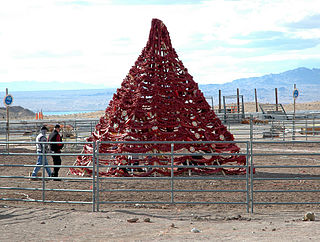
Fireworks are a class of low explosive pyrotechnic devices used for aesthetic and entertainment purposes. The most common use of a firework is as part of a fireworks display, a display of the effects produced by firework devices.

Pyrotechnics is the science and craft of creating such things as fireworks, safety matches, oxygen candles, explosive bolts and other fasteners, parts of automotive airbags, as well as gas-pressure blasting in mining, quarrying, and demolition. This trade relies upon self-contained and self-sustained exothermic chemical reactions to make heat, light, gas, smoke and/or sound. The name comes from the Greek words pyr ("fire") and tekhnikos.

A firecracker is a small explosive device primarily designed to produce a large amount of noise, especially in the form of a loud bang, usually for celebration or entertainment; any visual effect is incidental to this goal. They have fuses, and are wrapped in a heavy paper casing to contain the explosive compound. Firecrackers, along with fireworks, originated in China.

In an explosive, pyrotechnic device, or military munition, a fuse is the part of the device that initiates function. In common usage, the word fuse is used indiscriminately. However, when being specific, the term fuse describes a simple pyrotechnic initiating device, like the cord on a firecracker whereas the term fuze is used when referring to a more sophisticated ignition device incorporating mechanical and/or electronic components, such as a proximity fuze for an M107 artillery shell, magnetic or acoustic fuze on a sea mine, spring-loaded grenade fuze, pencil detonator, or anti-handling device.
The Green Man is an ancient European symbol of nature.

East Hoathly with Halland is a civil parish in the Wealden District of East Sussex, England. The parish contains the two villages of East Hoathly and Halland, two miles (3.2 km) to the west; it sits astride the A22 road, four miles (6.4 km) north-west of Hailsham, although the original sharp bend on that road through East Hoathly has now been bypassed.

L'International des Feux Loto-Québec, also known as the Montreal Fireworks Festival, is the largest and most prestigious fireworks competition in the world. It has been held yearly in La Ronde over the Dolphins lake, since 1985, and is named after its main sponsor, Loto-Québec. It hosts an estimated 3 million spectators each year, with approximately 6,000 fireworks set off during each show. Each summer, eight or nine pyrotechnical companies from different countries present a 30-minute-long pyromusical show, competing for the Gold, Silver and Bronze Jupiters or trophies.

GlobalFest is an annual cultural celebration in Calgary, Alberta, Canada.
The Pyrotechnics Guild International or PGI founded in 1969 is an independent worldwide nonprofit organization of amateur and professional fireworks enthusiasts. Its membership is the largest pyrotechnic community in the world.
The Philippine International Pyromusical Competition initially known as the World Pyro Olympics, is an annual competition among fireworks manufacturers from different countries held in the Philippines which runs for five days for World Pyro Olympics and 6 weeks for The Philippine International Pyromusical Competition. Two countries fire each day; the last participant fires on the final evening of the event.

At the 1976 P.G.I. Convention in Grand Junction, Colorado, member Robert (Rob) Berk came up with the idea of connecting a series of firecracker strings together in order to make a "superstring". Fellow members Lino Nivolo, Rudy Schwerdt, and Bob Luke collaborated in the construction. The final count of this first attempt was approximately 2,000 firecrackers. The excitement of building this string increased the following year at the annual convention in St. Croix Falls, Wisconsin when the superstring exceeded the hundred-thousand mark. To add to the excitement, auctioneer Rob Berk pounded the gavel as Lou Czaplewski paid $25 for the right to light it. Over the years, the superstring has increased in size and the amount paid to light it has exceeded $4,000.
John Shank was an actor in English Renaissance theatre, a leading comedian in the King's Men during the 1620s and 1630s.
Andrew Crooke and William Cooke were London publishers of the mid-17th-century. In partnership and individually, they issued significant texts of English Renaissance drama, most notably of the plays of James Shirley.
This is a list of worldwide fireworks competitions.

Sydney New Year's Eve is an annual multi-tiered event held every New Year's Eve in Sydney, Australia. Centring on the Sydney Harbour Bridge and surrounding Port Jackson, its main events are two pyrotechnic displays: the 9 pm Family Fireworks and the Midnight Fireworks, both of which are televised nationally with the more popular Midnight Fireworks televised globally.

A spark is an incandescent particle. Sparks may be produced by pyrotechnics, by metalworking or as a by-product of fires, especially when burning wood.

John Babington, was an English mathematician and gunner.

Mexican handcrafted fireworks production is mostly concentrated in the State of Mexico in central Mexico. The self-declared fireworks capital of Mexico is Tultepec, just north of Mexico City. Although the main ingredient for fireworks, gunpowder, was brought by the conquistadors in the 16th century, fireworks became popular in Mexico in the 19th century. Today, it is Latin America’s second largest producer, almost entirely for domestic use, with products ranging from small firecrackers to large shells and frames for pyrotechnics called “castillos” (castles) and “toritos”. The industry is artisanal, with production concentrated in family-owned workshops and small factories with a number operating illegally. The relatively informal production and sales of fireworks have made it dangerous with a number of notable accidents in from the late 1990s to the present, despite attempts to safety regulations.

The Reverend Ronald Lancaster is an English Anglican clergyman, chemist, businessman and retired teacher, having taught chemistry at Kimbolton School from 1963 to 1988. He is a fireworks manufacturer, having founded and remained owner of Kimbolton Fireworks, the last manufacturer of fireworks in the UK before their closure in February 2019.













